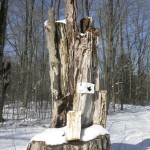This sugarbush is very old and many maple trees remain healthy for about 400 years. Able to withstand a lot of stress, the maples are very resilient. Unknown threats include a severe ice storm or a new insect, such as ALB, the Asian Longhorn Beetle or EAB, the Emerald Ash Borer. Since casual observers report most infestations, it is helpful to be informed. If you see several half-inch holes in a tree with fine sawdust at the base, speak up.
Springtime tapping of the maple trees also means a sugar-maker will drill a small hole in the tree, also producing sawdust, so a person should not mistake this activity as the work of an Asian beetle. Tap holes are 2 inches deep and about 5/16 of an inch in diameter. Hurry Hill uses a gas powered “tapper” and a metal “spile,” serving as a sort of spigot, is gently hammered into the hole. Metal buckets, with lids, are used for collecting the sap. Care is taken to drill new holes at least 12 inches above or below a scar from an old hole, and at least 6 inches to the left or right of a former taphole.
Notice the old taps visible on this piece of wood and in this tree recently cut down. Each hole likely yielded 10-12 gallons of sap each year, which was boiled down to about a quart of maple syrup. Ideal conditions for strong sap flow are sunny days above 40 degrees paired with frosty nights. Some call this the “season of mud and snow.” Old timers invented rhymes to explain when the sap runs best, such as:
When the wind is in the east, Then the sap will run the least.
When the wind is in the west,Then the sap will run the best.
Actually, at Hurry Hill it runs the “best” when the wind is in the southwest!
Sugaring involves both science and art. An experienced maple producer relies not merely on a thermometer to take advantage of a short 6-week season; even then, the sap runs irregularly on only about 10-20 of those 42 days. In fact, in just one week, the flow of sap may be so strong that the yield is 30% of the entire season’s take.
Early sap runs make a delicate-tasting syrup colored golden, with later runs boiling down to darker colors and more robust tastes. Once the buds swell, the taste becomes undesirable and is termed “buddy.”
(Use the Walking Trail sub-menu above to navigate to other stops on the trail)

